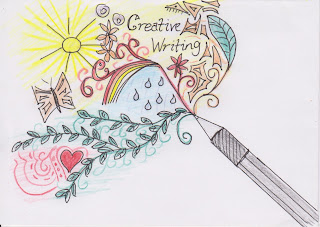What is Creative Writing?
Creative writing is difficult to define. It is the art of making things up;
illuminating truths about the world and the people in it in an interesting and
attractive way. Creative writing is
original and self- expressive. Genres of
creative writing include poetry, movie or play scripts, song lyrics and novels.
Why is Creative Writing important?
Creative writing develops thinking in children which extends
far beyond their writing. Being able to
think creatively means being able to think outside the box and use imagination,
which is essential for all types of problem solving.
Creative writing is also a useful outlet for
self-expression – sometimes it’s hard to work your way through a problem,
express your feelings, or work out your own morals, but writing it down as a
problem for a character to face, or in poetry or song lyrics helps to work it
through and get it out.
Thinking about
characters, their motivations and feelings helps to develop empathy.
Being able to express yourself clearly will
lead to a lifetime of clear communication.
How to develop Creative Writing in children.
Most of these activities are for Primary School children,
and can be done in class or workshop situations, but there’s nothing to stop
them from being adapted and used at home or with younger or older children or
even adults.
- · The most important thing to do to develop creativity is to get lots of experience. It’s difficult to write about a beach on a far-off planet, or a treasure island, if you’ve never been to the seaside or seen the ocean. It’s difficult to write convincingly about something happening at a football match if you’ve never been to one. While extensive reading, and watching television and films, can begin to bridge this gap, it’s no substitute for real first-hand experience. While it’s true that if you lead a cloistered life, you can still write beautiful creative fiction or poetry simply by sticking to what you do know, or by creating something entirely from the realm of fantasy, wide experience gives you a lot more to draw from.
- · Role play helps children to think through how characters might react to different situations, and how dialogue works. Extended role play helps them to think about what makes a good story – a role play game of mums and dads where they get up, go to work and make dinner is all well and good for a while, but children soon work out that things get a lot more interesting if there is conflict or a problem to solve.
- · Encourage children to describe using all of their senses. A walk in the woods – what can you hear? What do you see? What colours are all around you? What do you smell? What does the air taste of? What do the tree trunks feel like? What does this peach smell like, taste like, feel like, look like and sound like?
- · Pick any object or phenomenon and come up with as many similes and metaphors as you can. For example, “this daffodil… is like a patch of summer… is like a beam of sun… is like a smiling face… is a fresh faced child on a spring morning…” “The wind… is like a toddler tantrum, fierce and loud… is like a rollercoaster ride… is like a bully in the playground…”
- · Start creative journaling. Regularly open the journal to a new page and write something. It might be a description of the view outside, a story opening, a descriptive passage about an imaginary character, or a poem. Anything you like, as long as it’s unique and expressive.
- · Create a character together. Pick a name at random from the phone book. How old do you think this person might be? What’s their ethnic background? What’s their family situation? What kind of person are they? What do they look like?
- · Take the previous suggestion to the next level. Either using a character from a known story, or an invented character – start to think about how they would behave in different situations. Is their bedroom tidy? How would they behave at a football match? Would they make a good friend? If you lived next door, what would their garden be like? Would they feed your fish while you were away?
- · Once they can describe a person, an object or a situation using all their senses and some wonderful descriptive adjectives and similes, it’s time to introduce them to ”show, don’t tell”. Think about their character eating a peach. We could tell: “He ate a juicy peach”, or we could show: “He bit into the peach, and hurriedly wiped away the sticky juice that dribbled down his chin” which also gives information about the character and how he might be feeling.
- · When you’re reading stories and poems together, stop and think about what description the author or poet has used. How do they describe the character? How have they begun the story? How have they brought it to an end? Is their dialogue long and descriptive or short and punchy? How do we know how the character is feeling in this situation?
There is so much to
include in this topic, that we’ve only really covered description of place and
character, and haven’t even got started on plot development or poem structure,
which is going to have to form the basis of a future blog post. Children are innately creative and
imaginative, so developing creative writing is simply about harnessing that,
getting them to use what they see around them, and find the words to put it on
paper as written art.



No comments:
Post a Comment